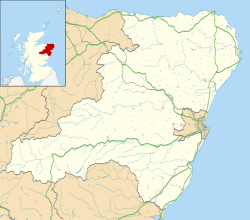Aquhorthies stone circle facts for kids

The circle in 2020
|
|
| Location | Scotland |
|---|---|
| Region | Aberdeenshire |
| Coordinates | 57.05801°N 2.16351°W |
| OS grid reference | NO901963 |
| Type | Recumbent stone circle |
| Site notes | |
| Public access | Yes |
| Designated | 1925 |
| Identifiers | |
| Historic Environment Scotland | SM971 |
Aquhorthies is a very old stone circle near Portlethen in Aberdeenshire, Scotland. It was built a long, long time ago, during the Neolithic (New Stone Age). This special place has a ring cairn (a low, circular mound of stones) and a recumbent stone circle. It's unusual because it has two rings of stones! Aquhorthies is a protected historical site, known as a scheduled monument.
What is a Recumbent Stone Circle?
A recumbent stone circle is a special type of stone circle. People built them in the early Bronze Age. The most important part is the "recumbent" stone. This is the biggest stone and it lies flat. Its longest side usually points between south and southwest.
Next to the recumbent stone are two "flanker" stones. These are usually the tallest stones in the whole circle. The smallest stones are on the opposite side, to the northeast. The rest of the circle has about six to ten other standing stones. These stones get smaller as they go around the circle.
Builders often chose flat spots on hills for these circles. This gave them great views of other important places. Over seventy of these circles are found in northeast Scotland. We don't know exactly why these circles were built. But burnt bone pieces have been found at some sites.
About the Aquhorthies Stone Circle
The Aquhorthies stone circle likely had two stone rings. It also had a ring cairn on a raised area. Today, fourteen standing stones are still there. Two of these are just stumps. Originally, there were at least 18 stones.
The ring cairn has been damaged over time. Only its outer edge, called the kerb, remains. The large recumbent stone is about 2.75 meters (9 feet) wide. It stands about 1.4 meters (4.5 feet) tall. One of its two tall flanker stones is now missing. This circle also has a unique open space in front of the recumbent stone. Aquhorthies became a protected site in 1925.
Exploring and Studying the Circle
Many people have visited and studied the Aquhorthies stone circle. In 1692, a person named James Garden visited it. He was asked to go by John Aubrey, who was interested in old sites.
Later, in the 1820s, artists James Skene and James Logan drew the circle. In 1858, a group of people dug into the site. This group included James Dyce Nicol and Charles Dalrymple. They found some burnt bone pieces and pottery sherds (broken pieces). The cairn had already been explored before their visit.
Many others visited in the late 1800s. These included William Collings Lukis and Christian Maclagan. In 1934, archaeologist Alexander Keiller noticed something interesting. He saw that the circle had an unusual number of stones. He also noted that their heights seemed to go up and down.
In 1955, Alexander Thom measured the site carefully. Later, in 1981, Clive Ruggles checked if the stones lined up with stars or the sun. A study of the rocks themselves happened in 2006.


